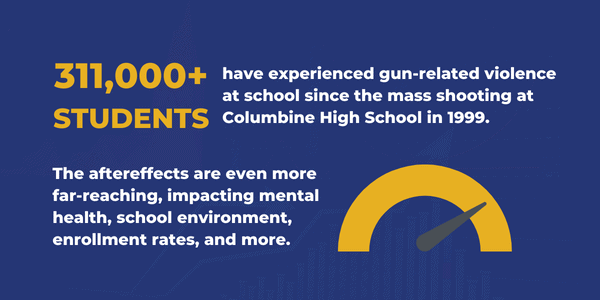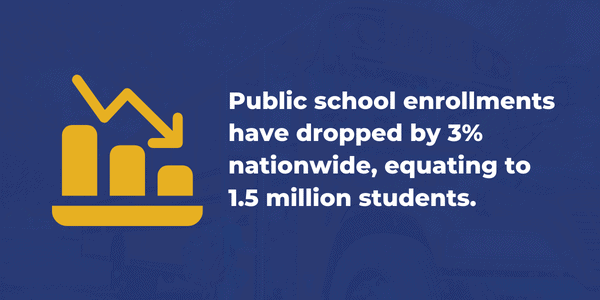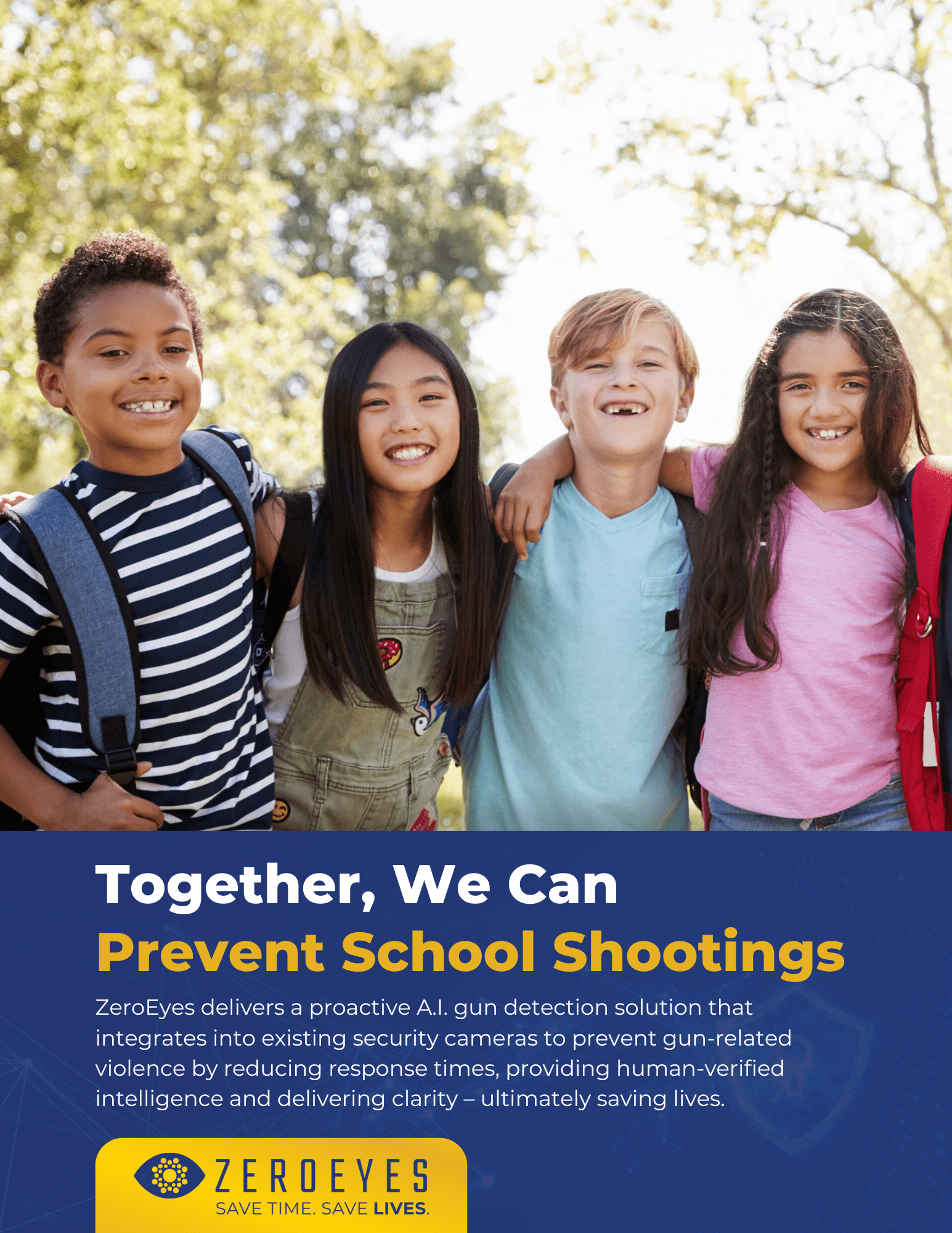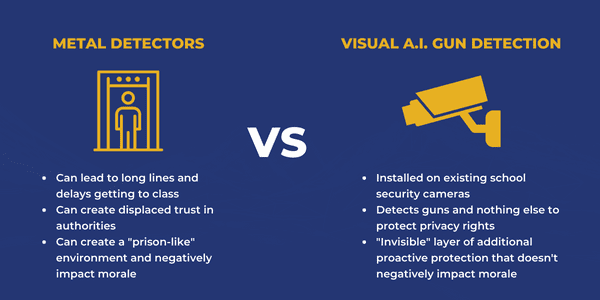Since the mass shooting at Columbine High School in 1999, more than 311,000 students have experienced gun-related violence at school. In recent years, we’ve seen an upward trend of school shootings, with at least 202 reported incidents in 2021—another sobering number in terms of mass shooting statistics. The lasting impact of gun-related violence, however, cannot be measured in these numbers alone.

Superintendents and educational leaders need to recognize that school shootings—regardless of where or how they take place—create serious, far-reaching effects, like decreased school enrollment. To solve this problem, school shooting prevention must become a top priority for leaders. And in light of a nationwide drop in public school enrollments, it’s time to consider how a rise in school shooting incidents may be fueling this trend.
Mass Shooting Definition—How it Affects School Policies
The Federal Bureau of Investigation (FBI) defines a mass shooting event as one with 4+ casualties, excluding the shooter. Even in gun-free zones, citizens are worried about the prevalence of mass shootings. This worry is often warranted, given that mass shootings are more likely to take place in densely populated areas or buildings, including school campuses.
Mass Shootings at Schools: How They Impact Student Mental Health and Enrollments
The level of personal safety that parents and children feel toward school can be seen through the drop in student attendance and enrollment. In the 2020-2021 academic year, there was a reported 3% drop nationwide in public school enrollments. This equates to 1.5 million students who ended up not enrolling in their traditional public school environment.

What is causing this sudden drop in enrollments? With the increase in active shooter incidents in recent years and the amount of news coverage that school shootings receive, it’s clear that families are aware of possible risks.
Mass Shooting Statistics
In 2018, the Pew Research Center collected data from students about their sentiments toward gun-related violence in schools. A majority of students expressed emotional or physical concern, and up to 57% of teens expressed worry about the possibility of a shooting happening at their school.
Students aren’t the only ones feeling anxiety about what could unfold. According to new data, only 28% of traditional public school parents surveyed felt that their children were reasonably safe on school grounds and property. This percentage is lower than the parents who feel safe sending their children to private or charter schools, but even so, nearly 70% of parents worry about their children’s safety while receiving their education.

Discover How You Can Prevent School Shootings
For more statistics about school shootings and how proactive gun detection can play a key role in preventing gun-related violence at schools, download our brochure.
Poor Mental Health and Morale: The Aftereffects of Mass Shootings Today
Unfortunately, the current generation of school-aged students is not exempt from hearing, reading about, or experiencing violent episodes at school.
Following the shooting at Robb Elementary School in May of 2022, TIME Magazine reported that school-age children are deeply affected by current news and shooting events. We are now witnessing a generation of children and teens who are more likely to experience PTSD, clinical anxiety, and even panic disorders in light of anticipated or experienced tragedies.
Developmentally, children are shouldering the weight of worries that are far beyond their years. This level of stress contributes to low morale within a school, which makes it more difficult for educators to create the types of educational experiences that are so pivotal to growing up. In teachers’ unions such as the American Federation of Teachers, a majority of educators now say that the threat of gun-related violence affects their daily school environment.
How Increased Physical Security Resources Can Impact Mental Health
To project an image of security and increased safety, many schools and educational facilities have implemented physical elements like metal detectors and security resource officers at entry points. While these measures are designed to communicate protection, evidence shows that students actually feel worse in their presence, not more reassured.
In schools, physical barriers may lead to long lines, delays getting to class, and even displaced trust in authorities. These methods are also seen disproportionately in schools with more minority groups, leading to the conclusion that these devices may actually hinder certain freedoms or give off the wrong message entirely.

In contrast, visual A.I. gun detection software can be installed seamlessly onto existing digital security cameras at schools. The result is a proactive, invisible layer of protection that doesn’t negatively impact student morale or mental health.

Have Questions About How ZeroEyes’ Visual A.I. Gun Detection Works?
Download our FAQs brochure to get answers to our most frequently asked questions and discover how you can improve safety with A.I. gun detection.
DOWNLOAD FAQ NOW
visuThe Rise In “Swatting” Calls Exacerbates Fear of Mass Shootings At Schools
Along with the rise in publicized school shooting incidents, there is also a more recent trend of active shooter hoaxes. This act is known as “swatting,” and it has a direct and proven impact on the rising fear of school shootings in K-12 public school environments.
This trend involves people calling in fake reports of active shooters at school either to disrupt classes or to instill fear in the community. Active shooter hoaxes visibly cause fear and disruption in the same way that an active shooter does—further traumatizing communities that may already be on edge.
Additionally, as schools and communities have to devote additional resources and time to reduce perceived threats and hoaxes, there are fewer resources available for other important goals, like boosting recruitment efforts, responding to declining enrollment numbers, or providing assistance to students in need.
Taking preventative measures today can help school leaders know precisely how to respond in the event of any type of threat (fake or real), which results in better resource allocation at all times.
Financial and Reputational Repercussions for Schools Facing Decreased Enrollment
When confronting school shooting prevention, a common reaction is that “it won’t happen here” because mass shootings are statistically rare. As a result, there isn’t an urgency to make noteworthy security improvements that could boost student and parent confidence, reverse declining enrollment trends, and most importantly, save lives.
Choosing to take a blind eye is dangerous, as reaction always costs more than prevention.
Although the repercussions of mass shootings are unique to each community, the consequences of this added stress are to be expected everywhere. This includes the loss of important funding, difficulty with creating a safer environment, and declining public image.
Loss of Funding Due to Decreasing Enrollments
It’s impossible to discuss the effects of student enrollment without acknowledging its impact on both budget and funding proposals. Public schools can receive funding in numerous ways, from grants, to state funding, to federal programming.
Despite the variety of ways schools can pay for academic and community programs, the hard truth is that declining enrollment affects how public schools balance budgets. Without the student numbers to support new initiatives, it’s challenging to request new or increasing budget allocations.
Jannelle Kubinec is the Chief Administrative Officer at WestEd, an educational nonprofit organization. Kubinec accurately summarizes the budget and enrollment relationship this way: “If your revenue is generated based on who shows up, you also have to be responsive to, how do we continue to be a place that people want to come to?”
Developing school safety strategies that are designed to proactively protect students in the event of an active shooter is one way to create an educational atmosphere worthy of funding.
Difficulty Creating a Positive School Environment
Building a positive and safe environment isn’t just about the design of a physical building. It also includes having confidence in the tools, resources, and systems that are in place to protect those that walk the hallways each day. Unfortunately, data shows that this confidence is often lacking in modern school environments.
A recent National Education Association Survey reports that up to 60% of teachers are worried about a mass shooting in their school. When teachers are distracted by fear and worried about whether there are resources in place to support them during such an unimaginable event, it’s tough to build an environment centered around learning.
Obviously, teachers feel the brunt of this from a workplace perspective, but parents and students are quick to pick up on these sentiments as well. Without confident teachers and recognizable resource support, parents may be less inclined to keep students enrolled. The problem becomes cyclical—with dropping enrollments and enduring worries.
Reputation and Public Image for the School
Between 1999 and 2021, more than 311,000 active students experienced some type of gun violence while at school. Not only that, but active shooting situations that happen on school campuses account for some of the highest casualty rates of any active shooter scenario. It’s no wonder that school officials are on edge, and it’s also understandable that families have a vested interest in knowing what steps schools are taking.
Unfortunately, many protocols and security playbooks don’t become public knowledge until after active shooter events take place. In the “fog of war,” chaos and confusion ensue, leading to displaced trust in authorities and broken public reputations.
Proactive Monitoring in Real School Environments
Let’s take a look at the Parkland, FL shooting. The shooter spent three minutes in the school’s parking lot and interior stairwell with his gun exposed on camera—but no 911 calls were made until he opened fire.
Had someone been monitoring the school’s security cameras, law enforcement could have arrived at the scene faster knowing who to look for. It’s a common misconception that security personnel are monitoring all security cameras at all times. In reality, it’s impossible to do so, which is why schools benefit from visual gun detection software installed on their digital security cameras.
Another issue that added to the chaos was the 130+ calls made to 911 with conflicting information. Law enforcement arrived not knowing where to go or who to look for, wasting precious time. For better active shooter response, law enforcement needs to know the shooter’s location, what they look like, and what they are armed with. This is just another example of how schools would benefit from a visual A.I. gun detection solution that provides law enforcement with all of the critical details they need to respond faster.
Without proactive planning, schools can expect to continually suffer enrollment shortages. Now is the time to act—not only to protect student lives, but to also ensure that the community at large acknowledges, trusts, and understands potential action plans.
Protect Students and Enrollments with Proactive Shooting Prevention Strategies
It goes without saying that the priority to protect and save innocent lives from public school shootings is more important than any other tangible goal. Although reducing the threat of shootings, hoaxes, and other events has direct benefits for school enrollments and educational environments, the protection of lives trumps all other ambitions.
To continue creating stable, safer, and more welcoming environments, school leaders and superintendents must take action now to proactively protect communities. The ideal way to do this is by investing in innovative technologies that identify and mitigate threats before those dangers unfold.
ZeroEyes’ visual A.I. gun detection solution integrates into schools’ existing digital security cameras to alert authorities at the first sight of a gun. Vetted and trusted by the Department of Homeland Security, we are currently helping protect schools nationwide, like Seminole County Schools, Oxford Community Schools, Vassar Public Schools, and more.
Download this guide to discover how visual A.I. gun detection makes it possible to prevent school shootings, provide peace of mind throughout K-12 school communities, and save lives.

